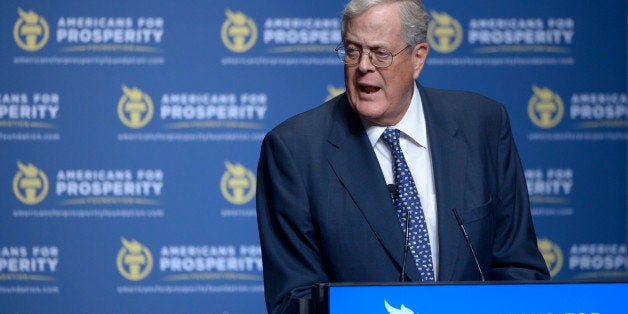
WASHINGTON -- A recent million-dollar settlement in California has stripped back the curtain on how "dark money" is secretly moved in and around electoral politics. Documents and interviews revealed how a networks of nonprofits passed dark money -- that is, money whose source is not disclosed to the public -- from one to another to another to further obscure the original sources.
Examples of similar financial transfers uncovered by The Huffington Post, in addition to a host of examples reported by the Center for Responsive Politics and NPR, demonstrate that the California case is no isolated incident.
Networks of nonprofits are being created across the country, at the national and state levels, to secretly fund candidate and ballot initiative campaigns, according to tax documents and campaign records accessed through Guidestar, CitizenAudit.org and the National Institute for Money in State Politics. Their tactics are similar to the schemes adopted by the global rich to hide their wealth -- except instead of avoiding tax collecting authorities, they're trying to skirt disclosure laws.
The best known of these networks are those tied to the billionaire Koch brothers. Linking the groups together are two dark money hubs: the Center to Protect Patient Rights, which doled out as much as $182.2 million to other dark money groups from 2010 through 2012, and Freedom Partners, which gave $236 million to other dark money groups, including $115 million to the Center to Protect Patient Rights.
But dark money networks have also grown at the state level. They played a notable role in the clashes over labor rights in Wisconsin and Ohio in 2011.
The Wisconsin battle erupted over a controversial budget bill, supported by Gov. Scott Walker (R) and passed in March 2011, that stripped public employees of their collective bargaining rights. An April vote for a state Supreme Court justice turned into a referendum on the legislation, and nine state senators were targeted in a recall election that August. Outside interest groups flooded these elections with millions of dollars, much of it spent on issue ads.
At the center of this effort were the Wisconsin Club for Growth, a spinoff of the national organization working to enforce conservative orthodoxy within the Republican Party, and the WMC Issues & Mobilization Committee, the political arm of the business trade group Wisconsin Manufacturers & Commerce. These two dark money groups not only spent money on their own issue ads, but also funded the activities of other nonprofits in the state.
In 2011, the Wisconsin Club for Growth gave $4.62 million to Citizens for a Strong America, which ran ads in two of the recall elections and in support of conservative incumbent Justice David Prosser. The only other contribution to Citizens for a Strong America that year totaled $25, making the organization merely a shell for Wisconsin Club for Growth cash. The "citizens" group has also been linked to staffers at the nonprofit Americans for Prosperity, the main political organization run by the Koch brothers.
Citizens for a Strong America, in turn, made big donations to two anti-abortion groups -- $916,045 to Wisconsin Family Action and $347,582 to Wisconsin Right to Life -- and to two gun rights groups -- $235,000 to United Sportsmen of Wisconsin and $77,908 to Safari Club International. All of these groups turned around and spent money on issue advertising in either the recall elections or the court race.
The $916,045 contribution to Wisconsin Family Action, which opposes gay marriage along with abortion, constituted 82 percent of its total moneys -- meaning that it too was almost entirely funded by the Wisconsin Club for Growth in 2011. As for Wisconsin Right to Life, the contribution from the Club for Growth spinoff that was funneled through Citizens for a Strong America constituted nearly half of its budget that year.
This dark-money shell game allowed the Wisconsin Club for Growth to influence the elections with both its own ads and those of seemingly unrelated conservative groups with different public agendas.
The one thing all these dark money nonprofits share is that they are not required by law to disclose their donors to the Federal Election Commission or any similar state agency. But they do report their own donations to the Internal Revenue Service. In other words, the trail of cash moving from dark money nonprofit to dark money nonprofit can be traced, in part, through public records of the groups contributing it.
Information available from the IRS on those contributing to the Wisconsin Club for Growth in 2011 turns up more links among dark money groups. These records showed a $225,000 contribution from the Center to Protect Patient Rights, $1.06 million from the Wisconsin Homeowners Alliance, $988,000 from the WMC Issues & Mobilization Committee, $227,500 from the Wisconsin Insurance Alliance, $140,000 from the Building Industry Council and $75,000 from the Jobs First Coalition. None of these groups reveal their donors.
A similar situation unfolded in Ohio, also in 2011, when the state's residents were asked to vote on a ballot initiative to decide the fate of Republican Gov. John Kasich's bill to strip public employees of collective bargaining rights.
The primary funding vehicle to support the anti-union measure was a dark money nonprofit called Building a Better Ohio, which transferred all its funds to a ballot initiative campaign of the same name. Corporations, unions and nonprofits have been able to contribute unlimited amounts to such campaigns since a Supreme Court decision in the 1980s.
More than half of the $12 million spent by the Building a Better Ohio campaign came from two other dark money nonprofits. Make Ohio Great, which was created by the Republican Governors Association solely for the ballot effort, contributed $1.55 million, and Ohioans to Protect Jobs gave $5.21 million. The only publicly known donor to Make Ohio Great was the Republican Governors Public Policy Committee, a dark money affiliate of the RGA that gave $2.85 million.
The Building a Better Ohio nonprofit did voluntarily release a list of donors but not the amounts given, leaving the public to guess its biggest funding sources.
The Wisconsin and Ohio cases, moreover, are only two high-profile examples of the endless layers obscuring dark money from the public's eye. In Arizona and Ohio, recent ballot initiative campaigns against health care reform were almost entirely funded by nonprofits, particularly those in the Kochs' orbit.
From 2009 to 2010, the Center to Protect Patient Rights, one of the main dark money hubs, gave $1.43 million to the U.S. Health Freedom Coalition and $275,000 to the Benjamin Rush League, another name for the U.S. Health Freedom Coalition, which turned around and gave $1.47 million to an Arizona ballot initiative campaign seeking to opt the state out of Obamacare's health insurance mandate. This was an effort endorsed by Americans for Prosperity, the Kochs' main political voice.
In 2011, Ohioans for Healthcare Freedom, campaigning for a ballot initiative identical to Arizona's, received nearly all of its funds from dark money groups. Donations included $198,438 from Ohio 2.0, $165,000 from Ohio Liberty Council and $100,000 from the U.S. Health Freedom Coalition -- three groups that all received substantial sums from the Center to Protect Patient Rights. The same year, the latter group gave $565,000 to Ohio 2.0, $210,000 to Ohio Liberty Council and $125,000 to the U.S. Health Freedom Coalition. The Center to Protect Patient Rights also gave $61,953 directly to the ballot campaign.
These dark money transfers are attracting more attention from other states' officials following the California case. Investigations exposed similar hide-the-source games in both Idaho and Kentucky.
Idaho Secretary of State Ben Ysura (R) forced Education Voters of Idaho to reveal the funders behind its efforts to pass a ballot initiative gutting collective bargaining rights for teachers. A court required the group to disclose its donors, which included New York City Mayor Michael Bloomberg and Wyoming investor Foster Friess. The Republican Governors Public Policy Committee also contributed $50,000.
In Kentucky, a conservative nonprofit called Restoring America was formed just months before the 2011 gubernatorial race and then funded a political committee of the same time, which ran ads attacking Democratic Gov. Steve Beshear. A court order forced those ads off the air until the group disclosed its donors. Terry Williams, the former father-in-law of Republican gubernatorial candidate David Williams, was revealed as the source of nearly all of Restoring America's funds.
An effort by Nevada Secretary of State Ross Miller (D) to force Americans for Prosperity to disclose its donors, however, was blocked in state courts last month.
Faced with this evidence of large sums of hidden cash moving into their realms -- and knowing the unlikelihood of any quick congressional action -- multiple states are looking to take more proactive steps. Election officials and watchdogs in Alaska, California, Idaho, Iowa, Maine, Maryland, Massachusetts, Montana, New York, New York City and Washington have banded together to form the States' Unified Network Center to collaborate on ways to prevent dark money from flooding future elections.

